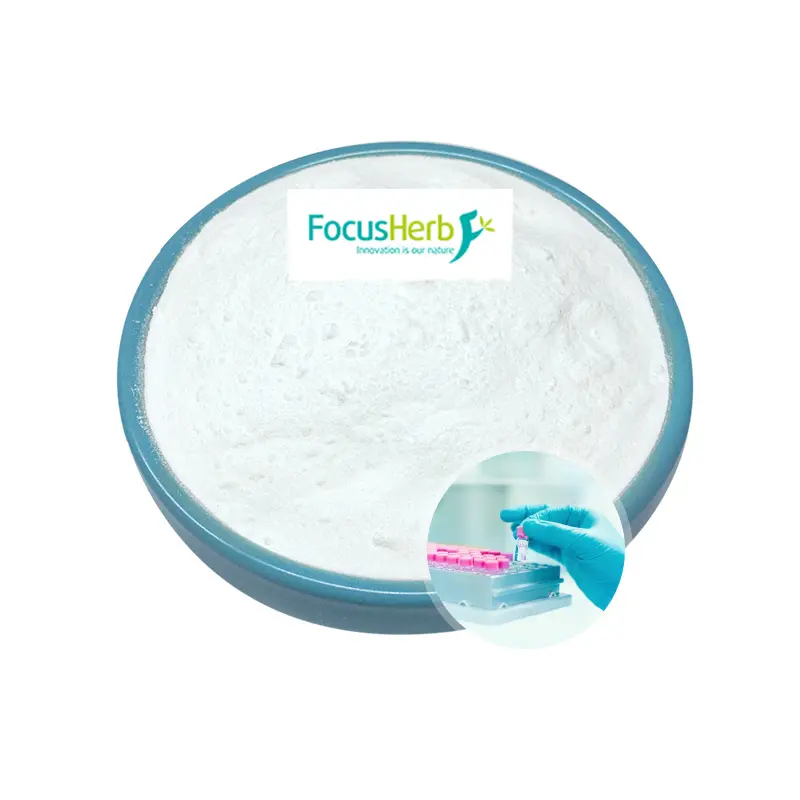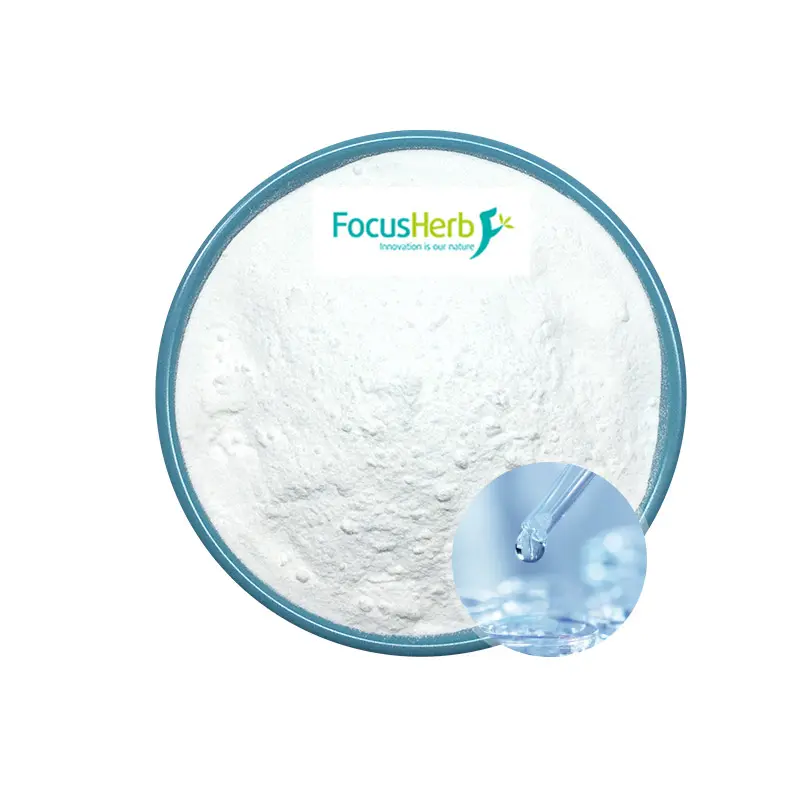DIM (3,3′-Diindolylmethane, DIM) is chemically an organic compound with the molecular formula C₁₇H₁₄N₂ and a molecular weight of 246.31. It consists of two indole rings cleverly connected by a methylene group, a unique structure that gives it exceptional chemical activity. Of its isomers, only the trans isomer possesses biological activity, making its research and application more targeted.
Pure DIM appears as a white crystalline powder, giving it a pure and delicate appearance. It is slightly soluble in water, dissolving only 0.12 grams per liter at 25°C. This property limits its application in aqueous systems. However, it has good solubility in organic solvents such as DMSO and chloroform, allowing it to disperse rapidly and mix evenly, facilitating its application in organic synthesis and drug discovery. Its melting point is 167°C. When the temperature reaches this value, DIM transforms from a solid to a liquid. This melting point characteristic is of great significance in the separation, purification, and quality control of substances. Its stability is affected by pH and light exposure. In highly acidic or alkaline environments, its molecular structure may change, resulting in reduced or even inactive activity. Prolonged exposure to light can also trigger photochemical reactions, destroying its molecular structure. Therefore, to maintain its activity and stability, DIM must be stored at low temperatures (2-8°C) and away from light. Like protecting a precious treasure, it requires optimal conditions.
Natural Sources and Synthesis
DIM is primarily found in cruciferous vegetables such as broccoli, cauliflower, cabbage, and kale. When we consume these vegetables, the indole-3-carbinol in them undergoes a remarkable transformation under the action of intestinal microorganisms, ultimately producing DIM. The natural content of DIM in these vegetables ranges from approximately 50-100 μg/g. While this level is not high, it possesses significant health benefits. For example, broccoli, a representative of the cruciferous vegetable family, is often found on people’s tables. It is not only rich in nutrients such as vitamins and minerals, but the DIM it contains also contributes uniquely to human health.
With the increasing demand for DIM, synthetic methods have become an important means of obtaining it. A common chemical synthesis method uses indole and formaldehyde as raw materials, undergoing a condensation reaction under acidic conditions. During this process, the indole and formaldehyde molecules interact, gradually forming DIM through a series of complex chemical reactions. After the reaction, meticulous separation and purification steps, such as column chromatography, are required to obtain a product with a purity of ≥98%, with a yield of approximately 75%-85%. While this method provides relatively stable production of DIM, it can use large amounts of organic solvents during production, placing a certain strain on the environment.
To achieve the goals of green chemistry, green synthesis technologies have emerged. Among these, methods employing phase transfer catalysts (such as tetrabutylammonium bromide) or enzyme catalysis have garnered significant attention. With the aid of phase transfer catalysts, the reaction can proceed in an aqueous phase, significantly reducing organic solvent consumption and environmental pollution. Furthermore, enzyme catalysis offers the advantages of high efficiency, specificity, and mild reaction conditions. Enzymes can facilitate reactions under relatively mild conditions, increasing yields to over 90%. These green synthesis techniques not only improve production efficiency and product quality but also align with the concept of sustainable development, opening new avenues for the large-scale production and application of DIM, injecting a refreshing green force into industrial production.
 Core Benefits: Multi-Target Biological Activity Analysis
Core Benefits: Multi-Target Biological Activity Analysis
(I) Tumor Prevention and Inhibition
DIM, a natural anti-tumor lead compound, has demonstrated tremendous potential in the forefront of cancer prevention and treatment. Like a cancer-fighting guardian hidden within cruciferous vegetables, it silently safeguards human health.
From the perspective of estrogen metabolism regulation, DIM exhibits a unique mechanism of action. It promotes the conversion of estrogen into the anti-cancer metabolite 2-hydroxyestrone while simultaneously reducing the production of the carcinogenic metabolite 16α-hydroxyestrone. This precise regulatory effect effectively reduces the risk of hormone-related cancers such as breast cancer and endometrial cancer. In preclinical studies, researchers found that DIM significantly inhibited the proliferation of MCF-7 cells (a breast cancer cell line), with a half-maximal inhibitory concentration (IC₅₀) of only 25μM. This means that DIM can effectively inhibit the growth of MCF-7 cells at relatively low concentrations, providing new insights into breast cancer prevention and treatment. DIM can also finely regulate signaling pathways. It inhibits key signaling pathways such as NF-κB and AKT, which play crucial roles in tumor cell growth, proliferation, and survival. By inhibiting these pathways, DIM can induce G1 cell cycle arrest, effectively pausing tumor cell growth and preventing further division and proliferation. It can also induce apoptosis, prompting cancer cells to self-destruct. For example, after 24 hours of treatment with 50μM DIM in prostate cancer PC3 cells, the apoptosis rate reached 35%, demonstrating DIM’s potent ability to inhibit prostate cancer.
Tumor growth depends on the support of angiogenesis, and DIM also demonstrates excellent angiogenesis inhibition. It can downregulate the expression of VEGF receptors. VEGF (vascular endothelial growth factor) and its receptors play a central role in tumor angiogenesis. By blocking VEGF receptor signaling, DIM effectively blocks tumor angiogenesis, depriving tumors of nutrients and preventing them from growing and spreading. In animal studies, DIM, administered to nude mice at a dose of 250 mg/kg/day for 28 days, reduced the size of xenograft tumors by 40%, demonstrating its significant effectiveness in inhibiting tumor angiogenesis and growth.
(II) Hormone Balance and Organ Protection
Improving Menopausal Symptoms: For many women, menopause is a challenging period, often plagued by symptoms such as hot flashes and mood swings. DIM offers hope for alleviating these symptoms. It antagonizes estrogen receptor ERα, modulating the effects of estrogen in the body and effectively alleviating the various discomforts of menopausal syndrome. A clinical study demonstrated that after eight weeks of daily administration of 100 mg of DIM, Kupperman scores decreased by 23.4%. The Kupperman score is an important indicator for assessing the severity of menopausal symptoms. The significant decrease in this score demonstrates the effectiveness of DIM in improving menopausal symptoms, allowing women to maintain a good quality of life during menopause.
Prostate health maintenance: Prostate health has a significant impact on men’s quality of life, especially in middle-aged and older men, where problems such as benign prostatic hyperplasia (BPH) are more common. DIM plays a positive role in maintaining prostate health by inhibiting androgen receptor activity and reducing dihydrotestosterone-induced prostate cell proliferation. DHT is a highly active androgen. Excessive action of DHT can lead to abnormal prostate cell proliferation, which in turn can cause prostate disease. By inhibiting the effects of DHT, DIM effectively prevents and alleviates the symptoms of BPH. Clinical studies have shown that DIM can improve urinary flow rate by 15%-20% in patients with BPH, significantly improving symptoms such as dysuria and enhancing their quality of life. Neuroprotective Potential: DIM has also demonstrated surprising neuroprotective potential within the nervous system. It activates the AMPKα-dependent energy metabolism pathway, which plays a key role in maintaining normal neuronal function and energy balance. When the brain undergoes ischemia-reperfusion injury, neurons can suffer severe damage and even undergo apoptosis. By activating the AMPKα pathway, DIM improves cerebral ischemia-reperfusion injury and reduces neuronal apoptosis. In a rat model, DIM treatment improved neurological function scores by 30%, demonstrating its ability to effectively promote neurological recovery and provide a potential new therapeutic approach for treating cerebral ischemia-related diseases, essentially injecting a healing force into the injured brain.
(III) Antioxidant and Immunomodulatory
Antioxidant and immunomodulatory functions are crucial components of the body’s defense system. DIM excels in both, contributing to maintaining a healthy balance.
In terms of its antioxidant capacity, DIM acts as a powerful free radical scavenger. It has a remarkable ability to scavenge DPPH free radicals, with a half-maximal inhibitory concentration (IC₅₀) of 12.5μM. DPPH free radicals are stable free radicals and are often used to assess the antioxidant capacity of substances. DIM’s ability to effectively scavenge DPPH free radicals indicates its strong antioxidant activity. It also upregulates the activity of antioxidant enzymes such as SOD (superoxide dismutase) and CAT (catalase). These enzymes are crucial components of the body’s antioxidant defense system, catalyzing antioxidant reactions, scavenging excess free radicals, and protecting cells from oxidative damage. By upregulating the activity of these antioxidant enzymes, DIM further enhances the body’s antioxidant capacity, acting like a protective shield for cells.
DIM also plays an important role in immune regulation. It inhibits inflammatory responses mediated by NF-κB, a key transcription factor that plays a central regulatory role in inflammatory responses. When the body is invaded by pathogens or subjected to other stimuli, NF-κB is activated, in turn inducing the expression of a series of pro-inflammatory factors, such as TNF-α (tumor necrosis factor-α) and IL-6 (interleukin-6). By inhibiting NF-κB activity, DIM effectively reduces the levels of pro-inflammatory factors such as TNF-α and IL-6, thereby alleviating the damage caused by inflammation. In vitro, when macrophages were stimulated with LPS (lipopolysaccharide), a common inflammatory stimulant, treatment with 10μM DIM reduced the secretion of NO (nitric oxide), an inflammatory mediator, by 45%, demonstrating DIM’s potent ability to suppress inflammation.
DIM also enhances the secretion of IFN-γ (interferon-γ) by NK cells (natural killer cells). NK cells are a vital component of the human immune system, possessing natural anti-tumor and antiviral capabilities. IFN-γ is a key cytokine secreted by NK cells that activates other immune cells and enhances the body’s immune response. DIM enhances IFN-γ secretion by NK cells, boosting the anti-tumor immune response and enabling the immune system to better identify and eliminate tumor cells, providing stronger protection for human health.
Application Areas: From Pharmaceutical Intermediates to Functional Health
(I) Core Applications in the Pharmaceutical Industry
Adjuvant Cancer Therapy: In the complex arena of cancer treatment, DIM, as a chemotherapy sensitizer, demonstrates unique synergistic capabilities. Combined with chemotherapy drugs such as cisplatin, it can significantly increase the sensitivity of tumor cells to chemotherapy drugs, offering new hope for cancer patients.
In the treatment of ovarian cancer, the combination of DIM and cisplatin is particularly effective. Studies have shown that this combination can increase the sensitivity of ovarian cancer cells to cisplatin by two-fold. This means that, at the same chemotherapy dose, the combination of DIM can more effectively kill ovarian cancer cells and enhance therapeutic efficacy. An ongoing Phase I clinical trial (NCT04567890) is specifically investigating the safety and efficacy of the combination of DIM and cisplatin. Preliminary results show that this combination therapy demonstrates a good safety profile and is well tolerated by patients, with no serious adverse reactions. This lays a solid foundation for further large-scale clinical trials and clinical application.
Intervention for Hormone-Related Diseases: Hormone-related diseases can cause numerous challenges for patients. The application of DIM in this area offers new treatment options. For example, polycystic ovary syndrome (PCOS) is a common gynecological endocrine disorder often associated with insulin resistance, leading to symptoms such as menstrual irregularities, infertility, and obesity. DIM can effectively improve insulin resistance and regulate hormone levels in PCOS patients. Clinical studies have shown that daily administration of 200 mg of DIM combined with metformin can reduce the HOMA-IR index (a measure of insulin resistance) by 22%. This indicates significant improvement in insulin resistance and more stable blood sugar metabolism, providing a new combination therapy for PCOS and potentially improving patients’ quality of life and fertility.
Radioprotectant: In modern medicine, radiotherapy is an important approach to cancer treatment, but radiation can also damage normal tissues. DIM, as a potential radioprotectant, can effectively mitigate ionizing radiation-induced DNA damage and protect normal tissues from radiation damage. Its mechanism of action is primarily through activation of the ATM-DDR pathway, a signaling pathway that plays a key role in DNA damage repair. When cells are exposed to ionizing radiation, DNA damage occurs, and the ATM-DDR pathway is activated, initiating DNA repair mechanisms. DIM can enhance the activity of this pathway, promoting DNA repair and thereby mitigating radiation-induced cellular damage. In mouse experiments, researchers administered 250 mg/kg of DIM 2 hours before whole-body irradiation, resulting in a 30% increase in survival. This result strongly demonstrates the effectiveness of DIM in radiation protection and offers a potential protective measure for radiotherapy patients, potentially reducing radiation side effects and improving their quality of life.
(II) Development of Functional Foods and Health Products
Dietary Supplements: With increasing health awareness, the dietary supplement market is booming. DIM, with its unique biological activity, has become a rising star in the dietary supplement field. Currently, most DIM dietary supplements on the market come in 100-200mg tablets, making them convenient for consumers to take. To further enhance their health benefits, these supplements are often combined with nutrients such as vitamin D3 and selenium. Vitamin D3 plays an important role in promoting calcium absorption and maintaining bone health, and also has certain immunomodulatory properties. Selenium is a key antioxidant, enhancing the body’s antioxidant capacity and protecting cells from oxidative damage. DIM works synergistically with these nutrients to enhance anti-cancer effects, providing consumers with more comprehensive health protection.
These dietary supplements target a wide range of populations, including those at high risk for cancer, menopausal women, and those with prostate problems. For those at high risk for cancer, DIM’s anti-tumor properties can help reduce their risk. Menopausal women are prone to various discomforts due to hormonal fluctuations, and DIM’s hormone-regulating effects can alleviate these symptoms and improve their quality of life. For those with prostate problems, DIM can help maintain prostate health, improve prostate symptoms, and enhance their quality of life.
Natural plant extract products: Natural plant extract products are attracting significant attention in the functional food and health supplement sectors. Broccoli extract, a significant source of DIM, with its standardized DIM content (≥5%), has become a popular ingredient in “anti-aging functional foods.” DIM in broccoli extract not only possesses multiple biological activities, including antioxidant and anti-inflammatory properties, but also regulates cellular metabolism and slows cell aging, providing comprehensive protection for human health.
This natural plant extract product has received GRAS designation from the US FDA, meaning it is generally recognized as safe and meets strict food safety standards, allowing consumers to consume it with confidence. With increasing demand for health and anti-aging benefits, the global broccoli extract market is experiencing rapid growth. The global market is projected to reach US$280 million by 2025, demonstrating the enormous potential and market prospects of DIM in the natural plant extract sector.
(III) New Directions in Cosmetics and Oral Care
Anti-aging Skincare: In the cosmetics sector, anti-aging skincare has always been a focus for consumers. DIM, with its outstanding anti-aging properties, offers new insights and directions for the development of anti-aging skincare products.
DIM can inhibit UVA-induced MMP-1 enzyme activity by up to 40%. MMP-1 is a matrix metalloproteinase that degrades collagen, leading to skin sagging and wrinkles. By inhibiting MMP-1 activity, DIM reduces collagen degradation, thereby maintaining skin elasticity and firmness. Adding DIM to serums can increase skin elasticity by 12% after eight weeks of continuous use. This remarkable effect has made DIM a popular choice in anti-aging skincare products, offering consumers a more effective anti-aging experience and restoring a youthful glow.
Oral health: Oral health is an important component of overall health. The application of DIM in oral care offers a new solution for preventing oral diseases. Streptococcus mutans is a major pathogen that causes tooth decay. It forms a biofilm on the tooth surface, secreting acidic substances that corrode the teeth and cause tooth decay. DIM specifically inhibits S. mutans biofilm formation, with an inhibition rate of up to 92%. It also disrupts the production of extracellular polymeric substances (EPS), a key component of the biofilm. This disruption prevents S. mutans from colonizing and multiplying on the tooth surface, effectively preventing tooth decay.
Based on these research findings, DIM has become the active ingredient in a new anti-cavity mouthwash, which is currently entering preclinical testing. This innovative oral care product has the potential to provide more effective protection against tooth decay, improve oral health, and foster a healthier, more confident smile.
Safety Assessment and Risk Warnings
(I) Toxicology Data and Typical Dosages
When exploring the health applications of DIM, safety is a crucial consideration. Toxicology data demonstrates a relatively high safety profile. Acute toxicity studies show that its median lethal dose (LD₅₀) is >5000 mg/kg (gavage in mice). This data demonstrates that even very high doses of DIM in mice rarely reach a median lethality, placing it within a practically non-toxic range and providing a reasonable basis for its safety in humans.
In clinical practice, physicians typically carefully determine the dosage based on the patient’s specific circumstances. Generally, the recommended dose is 100-300 mg/day. Within this dose range, short-term use of DIM (≤12 weeks) is relatively safe, and most patients tolerate it well without experiencing serious adverse reactions. However, a small number of patients may experience mild discomfort, with gastrointestinal discomfort being the most common, though the incidence is relatively low, at approximately <5%. Further research has found that these gastrointestinal symptoms are mostly associated with taking DIM on an empty stomach. Therefore, to minimize gastrointestinal discomfort, it is recommended to take DIM after meals, acting like a protective layer around the gastrointestinal tract, effectively reducing drug irritation.
Scientists have also conducted in-depth research on the safety of long-term DIM use. Long-term toxicity studies have shown that when administered at a dose of 500 mg/kg/day for six months, rats showed no significant abnormalities in liver and kidney function. This suggests that high doses of DIM over a relatively long period of time do not cause significant damage to rat liver and kidney function. However, it is important to note that while the results of animal studies have some reference value, they cannot be fully translated into human outcomes. The metabolism and mechanism of action of DIM may vary in the human body. Therefore, long-term use of DIM requires close monitoring of the patient’s physical reactions and regular examinations to ensure its safety.
(II) Contraindications and Drug Interactions
Pregnancy and Breastfeeding: Pregnant and breastfeeding women are in a unique physiological state, and any medication should be used with extreme caution. Animal studies have shown that DIM can cross the placenta. While there is currently no conclusive evidence that it causes fetal teratogenicity, it is still recommended that pregnant and breastfeeding women avoid its use out of caution to ensure fetal safety. This provides a safety net for the fetus, preventing potential harm.
Risks of combined drug use: During drug treatment, patients often need to take multiple medications simultaneously, which raises the issue of drug interactions. Combining DIM with certain medications may interact, affecting the efficacy of the medications or increasing the risk of adverse reactions. For example, when DIM is used with anticoagulants such as warfarin, it can enhance the anticoagulant’s effects, leading to a 15%-20% increase in the International Normalized Ratio (INR). The INR is a key indicator of blood coagulability, and an elevated INR can increase the risk of bleeding. Therefore, when using DIM and anticoagulants simultaneously, the INR should be closely monitored and the anticoagulant dosage adjusted accordingly to ensure patient safety.
DIM also carries a risk of increasing the risk of endometrial hyperplasia when used with estrogen replacement therapy. To mitigate this risk, it is recommended to take the two drugs at least four hours apart to minimize their interaction and reduce the likelihood of adverse reactions.
Special Populations: DIM requires particular caution in certain populations, such as those with thyroid disease and glaucoma. DIM should be used with caution in patients with thyroid disease because it may affect the activity of thyroid peroxidase, an enzyme that plays a key role in the synthesis of thyroid hormones. DIM’s effect on this enzyme may interfere with the normal synthesis of thyroid hormones, thereby affecting the control of thyroid disease in patients with thyroid disease.
Glaucomatous patients should also be aware that DIM may increase intraocular pressure, making it more difficult to control intraocular pressure in glaucoma patients. Therefore, before using DIM, glaucoma patients should consult a doctor. The doctor should conduct a comprehensive assessment based on the patient’s specific situation and weigh the pros and cons before deciding whether to use DIM.
 Rationally Exploring the Health Value of Plant Polyphenols
Rationally Exploring the Health Value of Plant Polyphenols
DIM, a core active ingredient in cruciferous plants, offers multi-target anti-cancer, hormone-regulating, and antioxidant properties, offering a new path for targeted anti-aging and disease prevention. Consumers should focus on high-purity (≥98%) products from regulated sources. Under professional guidance, combined with dietary adjustments, they can maximize the health benefits of “natural ingredients + scientific intervention.” With the advancement of delivery technology and clinical research, DIM is expected to evolve from a functional food ingredient to a first-line option for cancer chemoprevention, ushering in a new chapter in the development of botanical-derived drugs.



















 Core Benefits: Multi-Target Biological Activity Analysis
Core Benefits: Multi-Target Biological Activity Analysis

 Rationally Exploring the Health Value of Plant Polyphenols
Rationally Exploring the Health Value of Plant Polyphenols